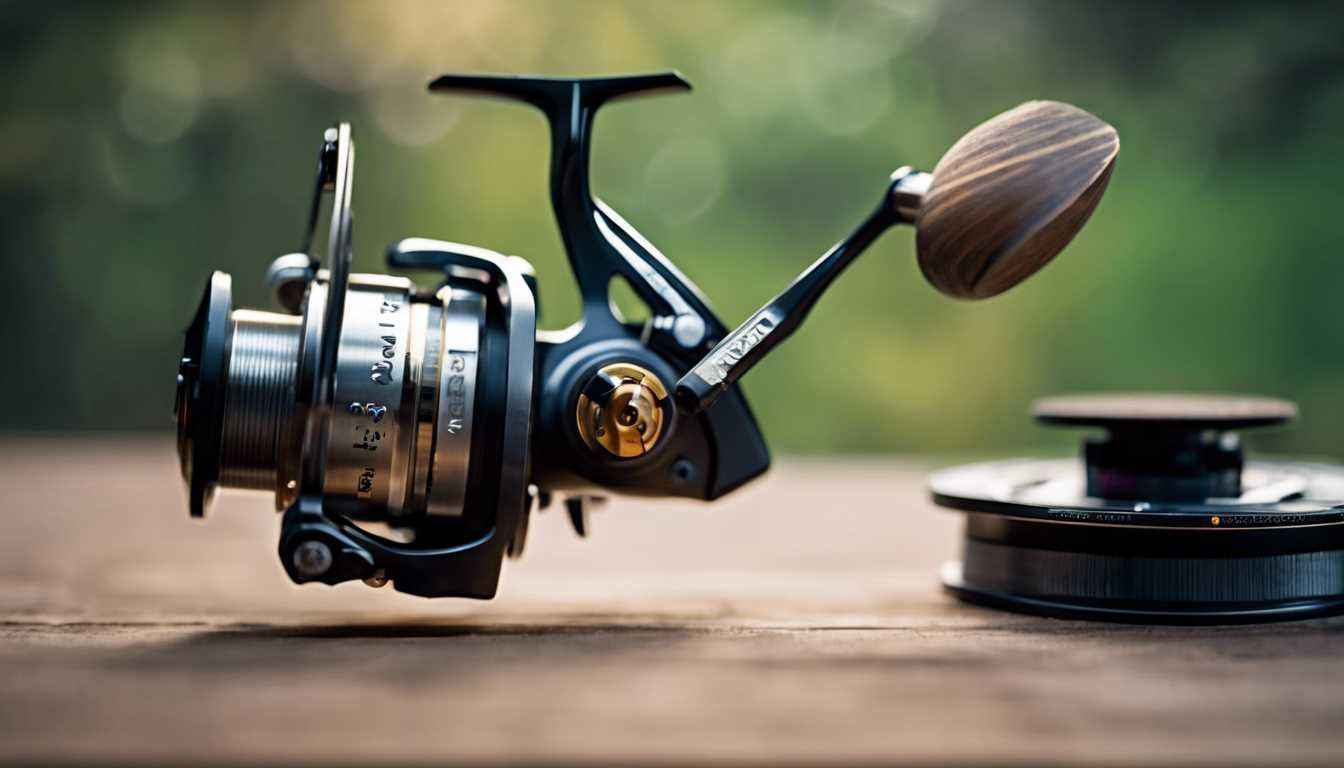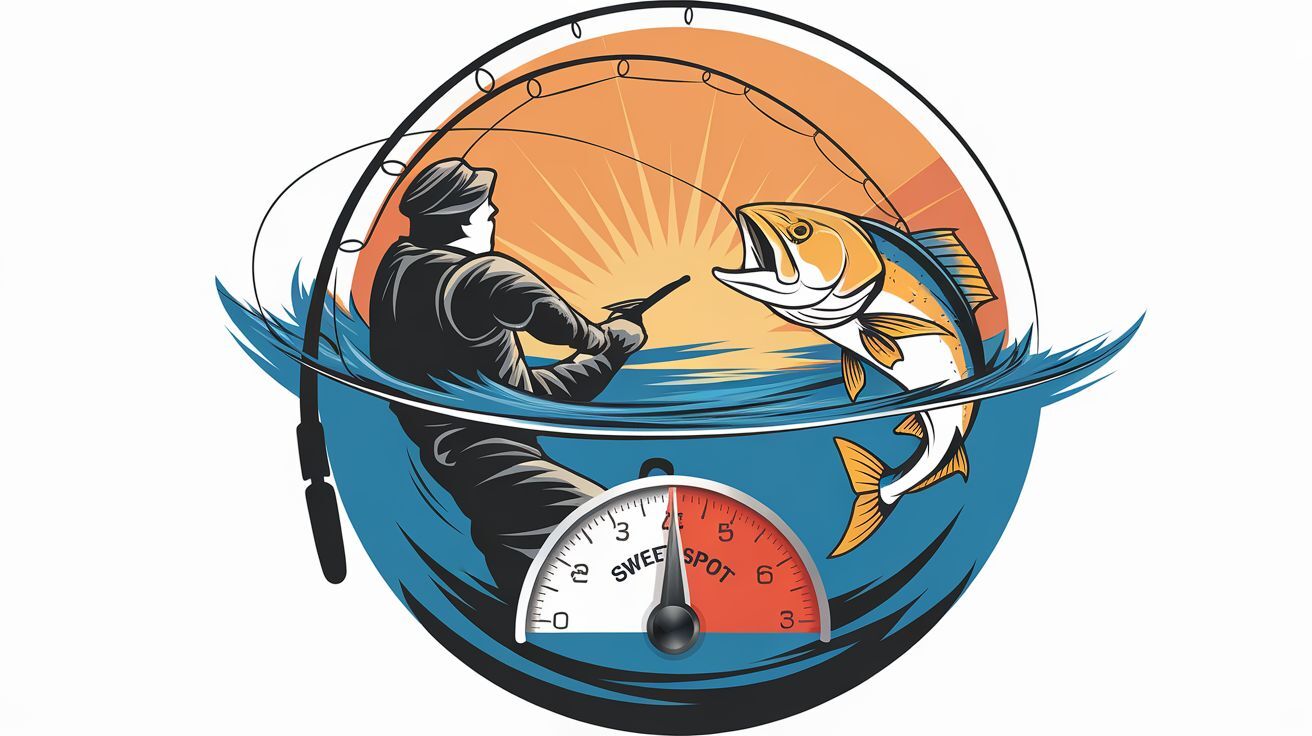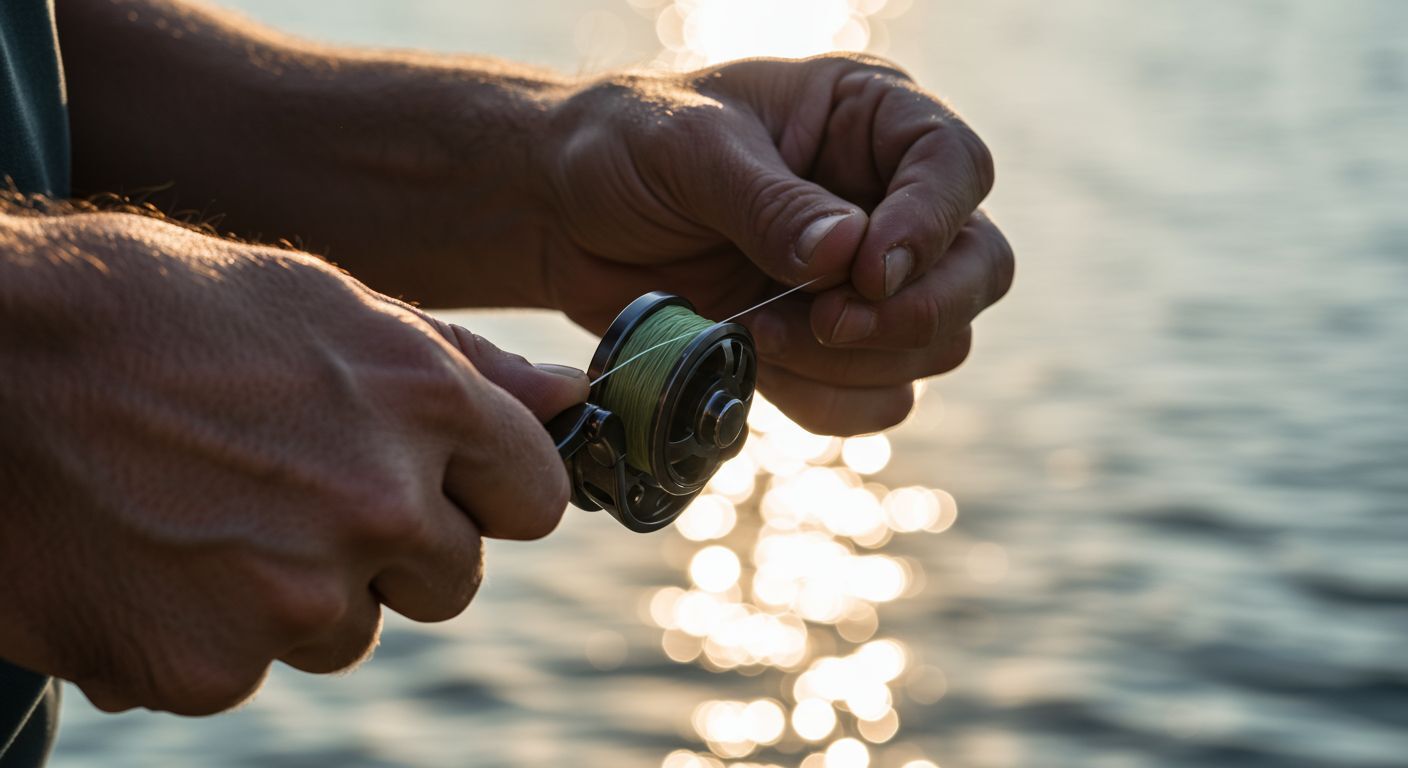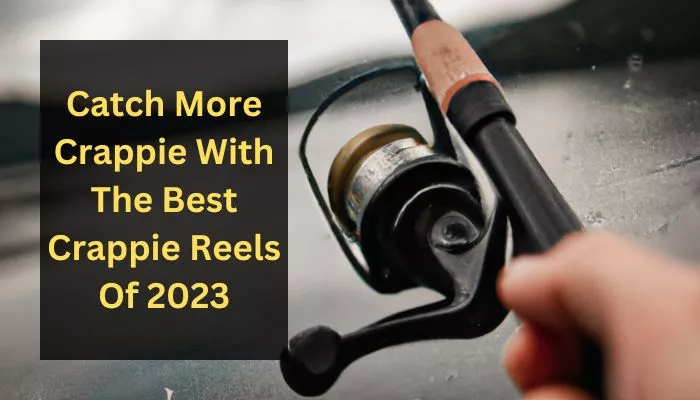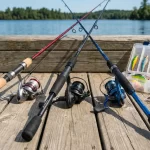I’ll never forget the frustration of my first baitcasting reel experience. Standing knee-deep in my favorite bass spot, watching what should have been a perfect cast turn into a tangled mess of fishing line that looked like a bird’s nest.
After twenty minutes of picking at the backlash with my fingernails, I nearly threw the entire setup into the lake.

That was fifteen years ago, and I’ve learned that the difference between baitcasting success and failure isn’t just technique—it’s understanding how braking systems work and how to set them up properly. After years of testing different baitcasting reels and their various braking technologies, I can confidently say that mastering your reel’s braking system is the single most important skill for preventing backlash and maximizing your casting performance.
Whether you’re considering your first baitcaster or looking to upgrade your current setup, this comprehensive guide will help you understand the science behind braking systems and provide practical techniques for backlash prevention that work in real fishing situations.
Understanding Baitcasting Reel Braking Systems
The Physics Behind Backlash
Before diving into specific braking systems, it’s crucial to understand why backlash occurs. When you cast a baitcaster, the spool rotates to release line as your lure flies toward the target.
The problem arises when the spool continues spinning faster than the lure can pull line off the reel. This creates excess line that tangles around the spool—the dreaded backlash.

The Role of Braking Systems
Braking systems serve two primary functions:
- Initial Speed Control: Managing the spool’s initial acceleration when you release your thumb
- Deceleration Management: Controlling the spool’s speed as the lure slows down during flight
The most effective braking systems provide strong control at high speeds while allowing free rotation at lower speeds—exactly what you need for long, accurate casts without backlash.
Types of Braking Systems Explained
Modern baitcasting reels employ three main types of braking systems, each with distinct advantages and applications:
1. Magnetic Braking Systems
- Use electromagnetic force to slow the spool
- Provide consistent, adjustable braking throughout the cast
- Excellent for windy conditions and various lure weights
2. Centrifugal Braking Systems
- Utilize friction-based brake blocks that engage based on spool speed
- Offer strong initial braking with minimal interference at low speeds
- Ideal for heavy lures and situations requiring precise control
3. Digital Control (DC) Systems
- Computer-controlled braking that adjusts in real-time
- Provide the most advanced backlash prevention
- Best for beginners and challenging casting conditions
Magnetic Braking Systems: The Modern Solution

Magnetic braking systems have revolutionized baitcasting reel performance, offering unprecedented control over spool speed without the wear and tear associated with friction-based systems.
How Magnetic Brakes Work
Magnetic brakes operate on the principle of electromagnetic induction. As the aluminum spool rotates through a magnetic field, eddy currents are created that naturally slow the spool’s rotation.
The braking force is directly proportional to the spool’s speed—faster rotation creates stronger braking, while slower speeds allow more freedom.
Advantages of Magnetic Braking
- Consistent Performance: Unlike centrifugal systems, magnetic brakes maintain consistent performance regardless of moisture, temperature, or wear.
- Smooth Operation: No friction means no noise, vibration, or mechanical wear.
- External Adjustment: Most magnetic systems allow you to adjust brake strength from outside the reel without disassembly.
Popular Magnetic Brake Systems
- Abu Garcia MagTrax: Features a dial-adjustable magnetic brake system that provides smooth, consistent braking across all Abu Garcia baitcasting reels in their modern lineup.
- Okuma MCS (Magnetic Control System): Offers external adjustment with precise control over brake strength, found in many budget-friendly Okuma baitcasting reels.
- KastKing AutoMag: Utilizes a one-piece ring magnet design for uniform braking force throughout the entire cast, featured in their MegaJaws series.
Centrifugal Braking Systems: Traditional Reliability

Despite being an older technology, centrifugal braking systems remain popular among experienced anglers for their unique performance characteristics and reliability.
How Centrifugal Brakes Work
Centrifugal systems use small brake blocks or pins that move outward due to centrifugal force as the spool spins. When spool speed increases, these blocks contact a brake ring, creating friction that slows the spool. The braking force increases exponentially with spool speed.
Advantages of Centrifugal Braking
- Superior High-Speed Control: Excellent for preventing backlash during the critical first moments of a cast.
- Minimal Low-Speed Interference: Allows the lure to fly freely at the end of the cast for maximum distance.
- Precise Adjustment: Individual brake blocks can be engaged or disengaged for fine-tuning.
Key Centrifugal Systems
- Shimano VBS (Variable Brake System): The gold standard for centrifugal braking, offering 8 individual brake blocks that can be adjusted for different casting conditions.
- Lew’s SmartPlus: Features a 6-pin system with different colored pins (white and blue) for varying brake strengths.
- Daiwa’s Traditional Systems: Found in many classic Daiwa baitcasting reels, offering reliable, time-tested performance.
Digital Control (DC) Systems: The Future of Backlash Prevention
Digital Control systems represent the pinnacle of braking technology, using computer-controlled algorithms to prevent backlash with minimal user input.
How DC Systems Work
DC systems use a sensor to monitor spool speed thousands of times per second. A microprocessor analyzes this data and applies precisely controlled magnetic braking to prevent overrun. The system continuously adjusts throughout the cast, providing optimal performance for varying conditions.
Advantages of DC Technology
- Virtually Backlash-Free: Advanced algorithms prevent overrun in almost all casting situations.
- Adaptive Performance: Automatically adjusts to different lure weights, wind conditions, and casting styles.
- User-Friendly: Simple dial settings make them ideal for beginners and experienced anglers alike.
Leading DC Systems
Shimano DC Brakes: Available in models from the budget-friendly SLX DC to the premium Shimano baitcasting reels like the Metanium DC. Features four casting modes: Max Distance, Braided/Monofilament, Fluorocarbon, and Finesse.
Daiwa DC Systems: Recently introduced their digital control technology, competing directly with Shimano’s established systems.
Spool Tension Adjustment: Your Foundation for Success {#spool-tension-adjustment}

While braking systems control spool speed during casting, the spool tension knob provides the foundation for proper reel setup. This critical adjustment determines how freely your spool rotates and directly affects casting performance.
Setting Spool Tension Properly
Step 1: Attach your lure and let out about 8 inches of line.
Step 2: Hold the rod at a 45-degree angle and release the thumb bar.
Step 3: Adjust the tension knob so the lure falls slowly and steadily without the spool overrunning when the lure hits the ground.
Step 4: Fine-tune by gradually loosening the tension until you achieve the desired balance between free spool and control.
Common Spool Tension Mistakes
- Over-tightening: Reduces casting distance and makes the reel feel sluggish.
- Under-tightening: Increases backlash risk and makes the reel difficult to control.
- Ignoring Lure Weight Changes: Different lures require different tension settings for optimal performance.
Brand-Specific Braking Technologies
Shimano’s Advanced Systems
Shimano baitcasting reels lead the industry in braking innovation:
- DC (Digital Control): Computer-controlled braking with four preset modes
- SVS (Shimano Variable Brake System): Adjustable centrifugal braking with 8 individual blocks
- FTB (Finesse Tuned Brake): Specialized magnetic system for ultralight lures
Daiwa’s Magnetic Excellence
Daiwa baitcasting reels feature sophisticated magnetic systems:
- MagForce Z: Advanced magnetic braking with speed-responsive control
- Air Brake System: Spring-loaded inductor cup for dynamic braking
- SV (Stress-Free Versatile): Optimized for various lure weights and casting styles
Abu Garcia’s Proven Technology
Abu Garcia baitcasting reels offer reliable braking options:
- MagTrax: Externally adjustable magnetic braking
- Centrifugal Systems: Traditional 6-pin brake blocks for precise control
- Dual Brake Systems: Combined magnetic and centrifugal for versatility
Lew’s Innovative Approach
Lew’s baitcasting reels feature multiple braking technologies:
- ParaMag: Paramagnetic braking system for consistent performance
- ACB (Adjustable Centrifugal Brake): 4-pin or 6-pin systems for different applications
- MCS (Magnetic Control System): External magnetic adjustment
Budget-Friendly Options
Best baitcasting reels on a budget often feature simplified versions of premium technologies:
- KastKing baitcasting reels: AutoMag dual braking systems
- Okuma baitcasting reels: MCS magnetic control systems
- Entry-level Shimano and Daiwa models with basic magnetic or centrifugal brakes
Practical Applications: Matching Brakes to Fishing Scenarios

Bass Fishing Applications
- Flipping and Pitching: Centrifugal brakes excel in these close-quarters techniques, providing minimal interference at low speeds while maintaining control for short, accurate casts.
- Crankbait Fishing: Magnetic brakes offer consistent performance for repetitive casts with varying retrieve speeds, making them ideal for covering water with reaction baits.
- Topwater Fishing: DC systems provide the confidence to make long casts without backlash, crucial for reaching distant boils or working large areas.
Saltwater Applications
Saltwater baitcasting reels require robust braking systems that can handle larger lures and harsh conditions:
- Magnetic systems resist corrosion and maintain performance in salt spray
- Sealed bearings in centrifugal systems prevent saltwater infiltration
- Corrosion-resistant materials ensure long-term reliability
Catfish Fishing Considerations
Baitcasting reels for catfish need to handle heavy weights and strong runs:
- Strong drag systems work in conjunction with braking systems
- Robust construction handles the stress of big fish and heavy tackle
- Reliable operation is crucial for night fishing and high-stakes situations
Species-Specific Setups
Round baitcasting reels often feature traditional centrifugal systems perfect for heavy-duty applications, while low-profile models typically use magnetic or DC systems for versatility.
Step-by-Step Setup Guide
Initial Setup Process
Step 1: Choose Your Line
- Monofilament: Easier to manage, more forgiving
- Fluorocarbon: Less visible, denser than mono
- Braided: Thinner diameter, no stretch
Step 2: Set Spool Tension
- Start with the lure you’ll use most
- Adjust for a slow, controlled fall
- Re-adjust when changing lure weights
Step 3: Configure the Braking System
- Magnetic: Start at 50% and adjust based on results
- Centrifugal: Begin with 2-3 blocks engaged
- DC: Select the appropriate mode for conditions
Step 4: Practice and Fine-Tune
- Start with short casts in an open area
- Gradually increase distance as confidence builds
- Make minor adjustments based on performance
Advanced Tuning Tips
- Wind Compensation: Increase brake settings when casting into headwinds, decrease for tailwinds.
- Lure Weight Optimization: Heavier lures may require less braking, lighter lures need more control.
- Rod Action Consideration: Fast-action rods may need more braking due to increased tip speed.
Troubleshooting Common Issues
Backlash Problems
- Frequent Backlash: Usually indicates insufficient braking or improper spool tension. Increase brake settings and check tension adjustment.
- Backlash at the End of Cast: Occurs when the lure stops but the spool continues spinning. Increase the magnetic brake or add centrifugal blocks.
- Backlash in Wind: Headwinds can cause lure deceleration. Increase brake settings for windy conditions.
Casting Distance Issues
- Short Casts: May indicate over-braking or excessive spool tension. Gradually reduce settings while maintaining control.
- Inconsistent Distance: Check for proper spool tension and consistent casting technique.
- Poor Performance with Light Lures: Consider reels with finesse-tuned braking systems or BFS (Bait Finesse System) models.
Mechanical Issues
- Brake System Maintenance: Keep centrifugal systems clean and properly lubricated. Check for worn brake blocks or contaminated surfaces.
- Magnetic System Care: Ensure magnets are properly positioned and external adjustments operate smoothly.
Maintenance and Care
Regular Maintenance Schedule
After Each Use:
- Rinse with fresh water if used in saltwater
- Check for line damage or wear
- Ensure smooth operation of all controls
Monthly:
- Clean and lubricate moving parts
- Check brake system components
- Inspect for corrosion or damage
Annually:
- Professional service for internal components
- Complete teardown and rebuild if needed
- Replace worn parts as necessary
Brake System Specific Care
- Centrifugal Systems: Clean brake blocks and rings with alcohol to remove oil and debris. Apply light lubrication to moving parts.
- Magnetic Systems: Keep magnets clean and check for proper alignment. Ensure external adjustments operate smoothly.
- DC Systems: Avoid moisture exposure to electronic components. Follow the manufacturer’s guidelines for care and storage.
Frequently Asked Questions
Q: Which braking system is best for beginners?
A: DC (Digital Control) systems offer the most user-friendly experience for beginners. They provide excellent backlash prevention with minimal adjustment required. However, they’re typically more expensive than magnetic or centrifugal systems.
Q: Can I use a baitcaster in saltwater?
A: Yes, but choose saltwater baitcasting reels specifically designed for marine use. Look for corrosion-resistant materials, sealed bearings, and robust braking systems that can handle salt spray and harsh conditions.
Q: How do I know if my brake system needs adjustment?
A: Signs include frequent backlash, reduced casting distance, or inconsistent performance. If you’re experiencing these issues, start by checking your spool tension and brake settings before making adjustments.
Q: Are expensive baitcasting reels worth it?
A: Higher-end reels typically offer better braking systems, smoother operation, and longer durability. However, many best baitcasting reels on a budget provide excellent performance for recreational fishing.
Q: How does line type affect braking system performance?
A: Braided line is thinner and lighter, requiring different brake settings than monofilament or fluorocarbon. Many DC systems have specific modes for different line types.
Q: Can I upgrade my reel’s braking system?
A: In most cases, braking systems are integral to the reel’s design and cannot be upgraded. However, some aftermarket modifications exist for specific models.
Q: What’s the difference between low-profile and round reels?
A: Round baitcasting reels typically feature traditional centrifugal braking and are designed for heavy-duty applications. Low-profile reels often use magnetic or DC systems and are more versatile for various fishing situations.
Q: How do I prevent backlash when learning?
A: Start with higher brake settings and gradually reduce them as your technique improves. Practice in an open area with consistent lure weights, and always use proper casting technique with controlled thumb pressure.
Conclusion: Your Path to Backlash-Free Fishing
Understanding braking systems is the key to unlocking your baitcasting reel’s full potential. Whether you choose magnetic, centrifugal, or DC braking, the most important factor is proper setup and practice. I’ve found that spending time learning your specific reel’s characteristics pays dividends in casting confidence and fish-catching success.
Remember that the best baitcasting reels aren’t necessarily the most expensive ones—they’re the reels that match your fishing style, target species, and skill level. Start with a quality reel that fits your budget, learn its braking system thoroughly, and practice regularly.
The journey from backlash frustration to casting confidence isn’t always easy, but it’s incredibly rewarding. With the knowledge you’ve gained from this guide, you’re well-equipped to make informed decisions about baitcasting reels and their braking systems.
Next Steps:
- Evaluate your current reel’s braking system capabilities
- Practice the setup techniques outlined in this guide
- Experiment with different brake settings for various fishing scenarios
- Consider upgrading to a reel with advanced braking technology if your current setup isn’t meeting your needs
Master your braking system, and you’ll discover why experienced anglers swear by baitcasting reels for precision, power, and fishing success.


